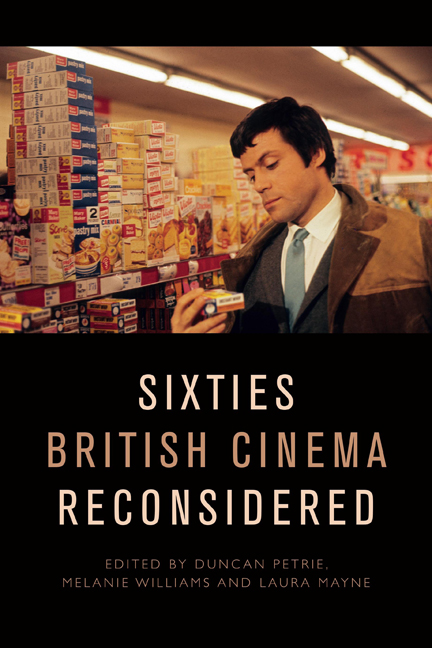Book contents
- Frontmatter
- Contents
- List of Figures and Tables
- Notes on the Contributors
- Introduction
- PART ONE STARS AND STARDOM
- 1 Male Stardom in 1960s British Cinema
- 2 ‘Rebel Rebel’?: Oliver Reed in the 1960s
- 3 Carol White: The Bardot of Battersea
- 4 ‘The Old Wave at Work’: The Transatlantic Stardom of the British Character Actress in the 1960s
- PART TWO CREATIVE COLLABORATIONS
- 5 Woodery-pokery: Charles Wood’s Sixties Screenwriting
- 6 ‘Beyond Naturalism’: Jocelyn Herbert, If . . . (1968) and Design for Performance in 1960s British Cinema
- 7 Kes: From Page to Screen
- 8 ‘I’d like to remember you as you are – as just a grumpy old man’: Joseph Losey and the Making of Figures in a Landscape (1970)
- PART THREE STYLE AND GENRE
- 9 ‘Wholesome rough stuff’: Hammer Films and the ‘A’ and ‘U’ Certificate, 1959–65
- 10 Widescreen Pyrotechnics: Shot Composition and Staging in the Cold War Films of Joseph Losey and Sidney J. Furie
- 11 The Rise and Fall of the Colourful Corporate Fantasy in 1960s British Cinema
- 12 Witchfinders and Sorcerers: Sorcery and Counterculture in the Work of Michael Reeves
- PART FOUR CULTURAL TRANSFORMATIONS
- 13 ‘An Impulse of Anger, Instantly Regretted’: Rebellion and Reaction in the Early-1960s Naval Film
- 14 Narratives of Race and Identity in Sixties British Cinema
- 15 Panic at the Disco: Brainwashing, Alienation and the Discotheque in Swinging London Films
- Index
13 - ‘An Impulse of Anger, Instantly Regretted’: Rebellion and Reaction in the Early-1960s Naval Film
Published online by Cambridge University Press: 22 September 2020
- Frontmatter
- Contents
- List of Figures and Tables
- Notes on the Contributors
- Introduction
- PART ONE STARS AND STARDOM
- 1 Male Stardom in 1960s British Cinema
- 2 ‘Rebel Rebel’?: Oliver Reed in the 1960s
- 3 Carol White: The Bardot of Battersea
- 4 ‘The Old Wave at Work’: The Transatlantic Stardom of the British Character Actress in the 1960s
- PART TWO CREATIVE COLLABORATIONS
- 5 Woodery-pokery: Charles Wood’s Sixties Screenwriting
- 6 ‘Beyond Naturalism’: Jocelyn Herbert, If . . . (1968) and Design for Performance in 1960s British Cinema
- 7 Kes: From Page to Screen
- 8 ‘I’d like to remember you as you are – as just a grumpy old man’: Joseph Losey and the Making of Figures in a Landscape (1970)
- PART THREE STYLE AND GENRE
- 9 ‘Wholesome rough stuff’: Hammer Films and the ‘A’ and ‘U’ Certificate, 1959–65
- 10 Widescreen Pyrotechnics: Shot Composition and Staging in the Cold War Films of Joseph Losey and Sidney J. Furie
- 11 The Rise and Fall of the Colourful Corporate Fantasy in 1960s British Cinema
- 12 Witchfinders and Sorcerers: Sorcery and Counterculture in the Work of Michael Reeves
- PART FOUR CULTURAL TRANSFORMATIONS
- 13 ‘An Impulse of Anger, Instantly Regretted’: Rebellion and Reaction in the Early-1960s Naval Film
- 14 Narratives of Race and Identity in Sixties British Cinema
- 15 Panic at the Disco: Brainwashing, Alienation and the Discotheque in Swinging London Films
- Index
Summary
On the 17 September 1961, a crowd gathered in London to demonstrate against the continued development of nuclear weapons. Earlier in January of the same year, prison mutinies broke out at Maidstone and Shrewsbury. Whilst far from encapsulating a mood of rebellion, such events did foreshadow huge societal shifts that would typify the so-called ‘countercultural rebellion’ of the 1960s. A nascent youth culture was also developing, typified by the fights between ‘Mods’ and ‘Rockers’ at Clacton, Margate and Brighton, leading to fears and ‘moral panics’ surrounding Britain's youth. In film, literature and theatre, the youth movement was exemplified by the work of the ‘Angry Young Men’, meanwhile, with East Enders once again fighting with Oswald Mosley's fascists, it is easy to look back at this era as being one of violent rebellion. Allied to this, the old certainties of empire were changing rapidly. The Suez and Cuban Missile crises had shown how isolated and insignificant Britain now was on the world stage. The former imperial power had become, in the words of Schyler and Auschul, a ‘strange island anchored off the continent’. It is within this context that a short cycle of British films emerged in 1962–3 that dealt with themes of mutiny, rebellion and resistance in Britain's most revered institution: the Royal Navy. This chapter will explore how HMS Defiant (1962), Billy Budd (1962) and Carry on Jack (1963), alongside the US production Mutiny on the Bounty (1962), served to open a fleeting window of enquiry into Britain's naval past and established notions of national identity.
THE BRITISH NAVAL FILM
The naval film had long been emblematic of all that was held sacred to British hearts and minds. The introduction of cinema coincided with the age in which Britain's Royal and Merchant navies patrolled and protected its vast empire. The ‘cult of the navy’ was such that the traditional ‘wooden walls’ that protected Britain were culturally revered as the apotheosis of British national identity, while the men who sailed in them – ‘jacks’ and ‘tars’ – represented the solid oaken heart of the nation, almost beyond ridicule or reproach. This was reflected in naval films from the earliest days of moving pictures, with films of ship launches and fleet reviews weaving the cult of the navy into a new audio-visual tapestry and thus providing powerful new propaganda opportunities to the institution.
- Type
- Chapter
- Information
- Sixties British Cinema Reconsidered , pp. 209 - 222Publisher: Edinburgh University PressPrint publication year: 2020

